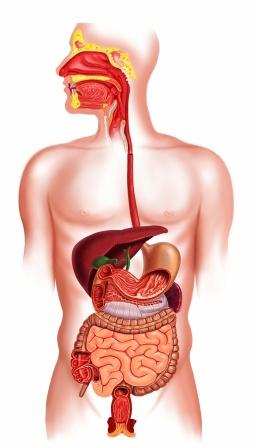Role Of Doshas In Gastro Intestinal Tract
By Dr Raghuram Y.S. MD (Ay) & Dr Manasa, B.A.M.S
The functions of gastro intestinal tract and related organs include acceptance, digestion and absorption of food. Waste byproducts of digestion are thrown out from terminal part of large intestine. Therefore excretion is also included among functions of gut.
Read – Understanding Digestion Process From An Ayurveda View
Table of Contents
Introduction

While digestion and following events keeps up nutrient levels of body high and enables formation of tissues and useful components which run body dynamics. Excretion helps in keeping our system clean and detoxified.
According to Ayurveda, doshas i.e. vata, pitta and kapha being functional components of our system, are involved in carrying out these functions of gastrointestinal tract. Different dosha sub-types are involved in different activities of gut.
Read – How To Know That Your Digestion System Is Working Fine?
Functions of doshas start right from consumption of food i.e. from mouth to excretion i.e. to level of rectum and anus. As in other systems, functions of GIT also are carried effortlessly and without hindrance as long as doshas are in a state of balance. But when these doshas are disturbed whole chain of mechanisms fails leading to hyperactivity or under-activity at various levels of GIT. This leads to many kinds of damages eventually resulting in many gastro-intestinal disorders.
Dosha – digestion governance
Governance of gastro intestinal tract – functions by Doshas
Hunger, initiated by Pachaka Pitta – When previously taken food is digested properly and when signs and symptoms of proper digestion of food are manifested, sub-type of pitta which digests food gets kindled once again indicating want of food.
Hunger is thus initiated by pachaka pitta. When pachaka pitta is weak, there is indigestion and consequently there is no desire for food.
This leads to –
loss of appetite,
indigestion,
anorexia and many other pathological conditions.
Read – Normal Dosha Vitiation In Relation To Digestion
When there is feeling of hunger, we need to supply food to stomach. When we do not eat food in presence of hunger, digestive fire which is located in form of digestive pitta in stomach starts acting on walls of stomach and intestines and digests them. This leads to manifestation of many complications like peptic ulcers, perforation etc.
Read – Normal Dosha Vitiation In Relation To Digestion
Bodhaka Kapha
Action of bodhaka kapha in mouth – When there is hunger, we take food. When we intake food, we first keep it into mouth. We often salivate when we see delicious food.
Bodhaka Kapha, located in tongue, creates an environment of acceptance of food in mouth, by moistening mouth, tongue, gums and throat. This sub-type of kapha also mixes food in its secretions after food is chewed by teeth. This chewed food, converted into bolus by admixture of bodhaka kapha now needs to be propelled down into food pipe.
Read – Relationship Between Doshas And Digestive Fire
Prana, Udana Vata
Prana Vata and Udana Vata allow entry of food – Prana Vata located in head should be in its normal state if food has to be gulped down food pipe. One cannot swallow food if prana vata is out of balance. But it is not enough. It needs cooperation from chest doshas, mainly udana vata.
Udana Vata located in chest tends to move upwards and has a functional direction opposite to that of prana vata. Udana vata needs to relax and allow prana vata to push food downwards into esophagus down into stomach.
If chest vata opposes head vata and is not in a state of balance, it doesn’t allow food to travel towards stomach. In fact chest vata pushes food in opposite direction and throws it towards mouth. This leads to vomiting, GERD etc conditions. These two vatas get cooperation from subtype of kapha located in chest, which allows free expansion of chest to allow downward travel of food towards stomach, avalambaka kapha.
Read – Understand Vata Dosha By Its Functions
Pachak, Saman, Kledak Doshas
Digestion of food by Pachaka Pitta, Samana Vata and Kledaka Kapha – In stomach, Kledaka Kapha moistens food and makes it smooth so as to enable its easy digestion. Pachaka Pitta which is also known as digestive fire, getting kindled and helped by samana vata, both of which are located in stomach and small intestine, digests food completely and properly.
Kledaka Kapha acts as a buffer and protects stomach and small intestine from corrosive action of digestive pitta. Digestive pitta also involves in reception of food and segregation of food into useful and useless components.
Useful components form nutrition and get absorbed in small intestine, put into circulation and reach all tissues of body through circulation. Absorption of food is also enabled by action of pachaka pitta.
Useless components form excreta, i.e. feces and urine and are propelled down into colon by action of pachaka pitta and Samana Vata.
After food is absorbed and put into circulation through heart, Vyana Vata distributes nutrition all through body.
Read – Diseases Caused Due To Waste Products – Mala Pradoshaja Rogas
Waste excretion
Excretion of waste byproducts of food by Apana Vata – After digestion of food has been completed in small intestine, food is now propelled to colon. Almost nutrients of food have been absorbed by the system by now.
Colon is seat of Vata. Lower portion of body, i.e. below navel belongs to Apana Vata. Precisely colon also falls into territory of Apana Vata. Due to action of vata in colon, digested food gets dried as its water content and useful minerals are absorbed into walls of colon. Eventually stools and fart are formed. They need to be eliminated from body so that our system keeps running smoothly without any obstruction.
Faeces and fart are expelled by action of Apana Vata. If they are not removed on regular basis, they create complications like flatulence, constipation etc. Vata disturbed due to withholding of faeces and fart will move in upward direction and impart pressure on abdomen and chest causing various disorders. Similarly, apana vata also enables voiding of urine from urinary bladder.
Read – Tri Malas – The Three Major Waste Matters Of Body
Formation of Doshas
Doshas are formed during different stages of digestion of food in gastrointestinal tract
While doshas are involved in digestion of food at various sites in gastrointestinal tract, they are expended and need to be replaced. As a part of give and take mechanism, doshas derive and retrieve themselves from tract at different stages of digestion of food. Doshas are no doubt formed and nurtured by food.
Food derives sweet taste as it gets digested in stomach. Due to this kapha is formed and nurtured. This is called Madhura Avastha Paka or sweet phase of digestion.
Read – Formation Of Doshas In Avastha Paka
In next stage, when food is pushed to lower stomach and upper intestines, chiefly duodenum, food gets sour taste. As a result, pitta is formed and nurtured. This phase of digestion of food is called amla avastha paka.
In final stage of digestion, vata is formed and nurtured in colon owing to manifestation of dryness and pungent taste in digested food. This stage of digestion, i.e. end phase of digestion is called katu avastha paka.
Read – Vipaka: Taste Conversion During And After Digestion
Click to Consult Dr Raghuram Y.S. MD (Ayu) – Email / Skype










